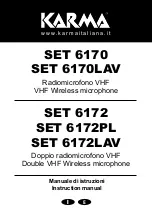
9
Installing antennas
Install antennas by connecting the two
antennas (19)
included with your system to
the two
rF Connectors (18)
located on the
back of your W-1KU receiver. The optimal
positions of the antennas are 45 degrees
from the receiver and 90 degrees from each
other. For maximum range, it is always best
to maintain a line-of-sight (no obstructions)
between the receiver antennas and the
transmitter at all times whenever possible.
Powering the receiver
To power the receiver, plug the provided
aC/DC Power Supply (14)
adapter into the
DC Input Jack (13)
on the back of the receiver,
then plug the adapter into an AC outlet.
Note:
Any 15-18VDC source with minimum
400mA capacity can also be used.
Connect either the
1⁄4” Unbalanced line
Out (17)
or
Xlr Balanced Mic Out (15)
to
your mixing board, effect, or amplifier
(see
Connecting the Audio Equipment
).
To turn on, press the
Power Button (12)
for two seconds. The
lCD Display (2)
will
light (showing Group, Channel, RF Level
Meter, Diversity, and Output Volume). The
5-segment
aF leD Tree (1)
will display the
received audio level when the transmitter is
activated and audio transmitted. To turn off,
press the Power button for three seconds
and release. The receiver will turn off.
adjusting the Squelch
The
rF Squelch (16)
simultaneously controls
both of the A and B True Diversity receiver
mute sections. The control should be
adjusted counterclockwise to the minimum
RF squelch setting at which the
rF level
Meter (7)
and the
Diversity Indicator (3)
will
remain on while your transmitter is in
normal use, up to the maximum operating
range anticipated in use for your application.
However, in areas of high RF activity, the
squelch control may need to be adjusted
clockwise. If the transmitter is off and the
receiver signal and the diversity indicators
are flickering or stay on continuously, the
squelch should be adjusted to a higher
level (clockwise for less mute sensitivity
level) to stop the flickering. Be careful
not to select too high a clockwise setting
as this may reduce the operating range
to below what is needed. A range walk
test will help in selecting the proper level.
If the range is not critical, note that a
clockwise (maximum squelch) setting will
also yield a quieter mute function, which
might be desired in certain applications.
The squelch level is factory preset at
maximum sensitivity and operating range
(i.e. counterclockwise for minimum squelch
level—maximum usable range).
audio level and Peak leD Indicator
The W-1KU receiver has a 5-segment
aF level leD Display (1)
that lights up
sequentially, indicating the level of the audio
signal from the transmitter. Occasional
flickering of the top (red) Peak LED on loud
inputs to the transmitter is normal. If the
Peak LED lights continuously decrease
the input audio level to the transmitter
or overload distortion may result.
Connecting the audio Output
The W-1KU audio output is set up for either
balanced mic (fixed level) or unbalanced line
(adjustable level). The Unbalanced Line Out
is controlled by the or volume control
buttons. The receiver
Volume Display (6)
will
indicate the level selected. For balanced
output, plug an audio cable with an XLR
connector into the
Xlr
Balanced Mic Out (15)
socket and plug the other end into your
mixing board or amplifier. For unbalanced
output, plug an audio cable with a 1⁄4”
mono (Tip/Sleeve) plug into the
Unbalanced
line Out (17)
jack and plug the other end into
your mixing board or amplifier. When using
the BT-1KU instrument transmitter system,
connect the Unbalanced Line Out directly
to your instrument amp or preamp.






































